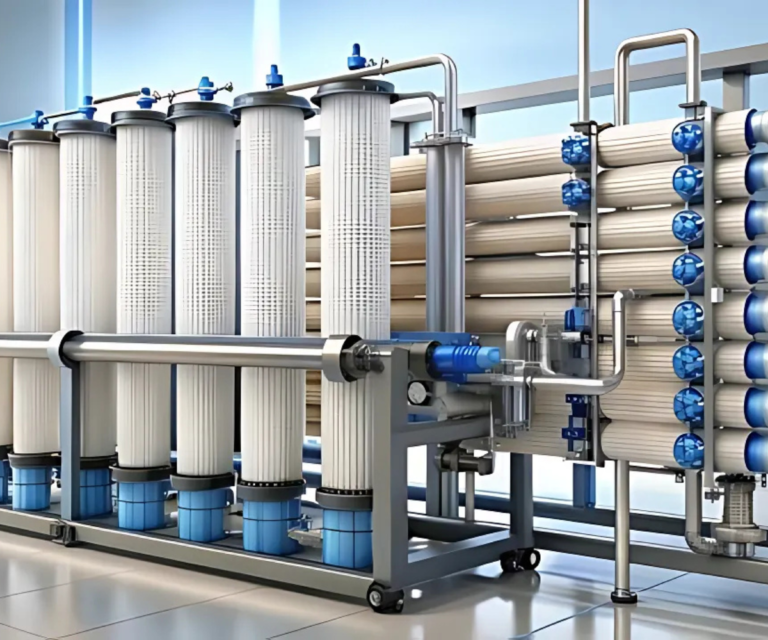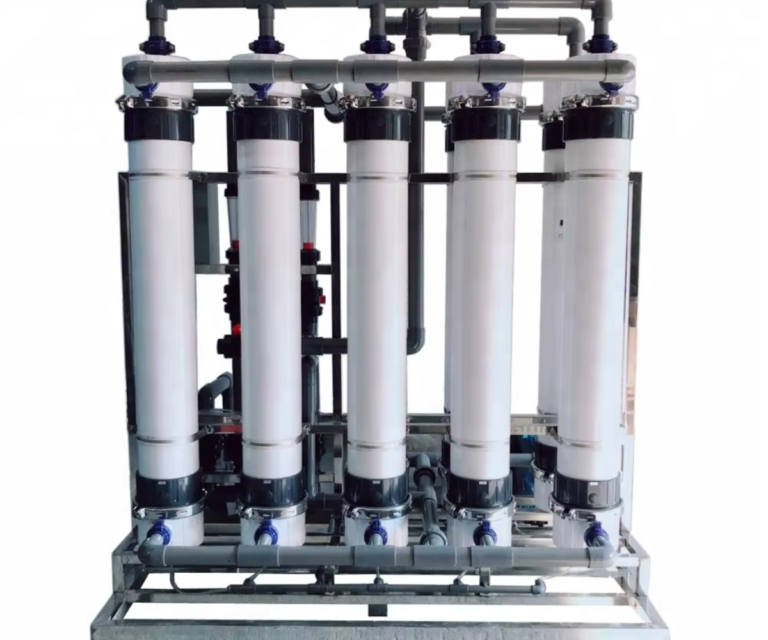Membranes with a pore size of 0.1 – 10 µm perform micro filtration. Microfiltration membranes remove all bacteria. Only part of the viral contamination is caught up in the process, even though viruses are smaller than the pores of a micro filtration membrane. This is because viruses can attach themselves to bacterial biofilm. Micro filtration can be implemented in many different water treatment processes when particles with a diameter greater than 0.1 mm need to be removed from a liquid.
Microfiltration And Ultrafiltration Membranes
Microfiltration
Microfiltration (MF) is a pressure-driven separation process, which is widely used in concentrating, purifying or separating macromolecules, colloids and suspended particles from solution. MF membranes typically have nominal pore sizes on the order of 0.1–1.0 μm. MF processing is widely used in the food industry for applications such as wine, juice and beer clarification, for wastewater treatment, and plasma separation from blood for therapeutic and commercial uses. In biotechnology industries, MF concerns applications such as cell recycle and harvesting, separation of recombinant proteins from cell debris, and purification of process streams.


MF is usually operated at relatively low TMPs (4 bar or 0.4 MPa) in a cross-flow configuration. The feed stream flows tangentially to the membrane surface to prevent cake formation and hence fouling of the membrane. The operation of cross-flow MF is often limited by membrane fouling caused by suspended solids in the feed stream. Permeate flux decreases with time as the retained particles accumulate on and within the membrane. Accumulation of cells, cell debris or other rejected particles on the membrane surface (external fouling or cake formation) is usually reversible, while deposition and adsorption of small particles or macromolecules within the internal pore structure of the membrane (internal fouling) is often irreversible.
Examples Of Micro Filtration Applications
- Cold sterilisation of beverages and pharmaceuticals
- Clearing of fruit juice, wines and beer
- Separation of bacteria from water (biological wastewater treatment)
- Effluent treatment
- Separation of oil/ water emulsions
- Pre-treatment of water for nano filtration or Reverse Osmosis
- Solid-liquid separation for pharmacies or food industries
Ultrafiltration
UF, a kind of membrane separation technique, is able to remove the particle materials in solutions. This separation process is usually used in industry and research areas for purifying and concentrating macromolecular (103–106 Da) solutions, especially protein solutions. Like microfiltration, ultrafiltration is based on size exclusion or particle capture. Ultrafiltration membranes are defined by the molecular weight cut-off (MWCO) of the membrane used, and cross-flow or dead-end mode is applied in different areas. The ultrafiltration membranes are only accessible for small molecules, such as leachate molecules, inorganic salts, and micromolecular organics, rather than some macromolecules like SS, colloid, protein, and bacteria. UF is always used as a way to pretreat leachate with lower organic concentration before nanofiltration (NF).


UF is used to treat wastewater to meet the municipal effluent discharge standards and to recover valuable component for recycle as in the case of oily wastewater. The sources of oily wastewater include metal works, textile industries, automotive, aeronautical and animal/vegetable fats industries and industrial laundromats. Hydrophilic UF membranes (e.g., polyacrylonitrile and PES) are used for recovering oil from oily waste waters instead of hydrophobic membranes (e.g., PVDF) that get fouled with oil resulting in loss of flux. The oil droplets are completely retained by the UF membrane, although the membrane is permeable to free (soluble) oil. UF permeate of highly stable emulsified feed stream can be discharged to a municipal wastewater system. The concentrated recovered oil is less than 5% of the original waste volume. Similarly, tubular UF membranes are used for treating industrial laundry wastewater to recover heavy metals such as lead and chromium to remove oil prior to effluent discharge.
Ultrafiltration is a popular separation process used for product recovery and pollution control in industrial wastes, wastewater treatment, oil emulsions, medical therapeutics, biological macromolecules, and colloidal paint suspensions. he main problem related to ultrafiltration process in industries is membrane fouling which limits the potential of this technique. Fouling affects the membrane performance and causes an increase in operating costs due to increased labor for maintenance and a shorter membrane life. Membrane cleaning is very essential to significantly influence membrane performance. Membrane cleaning can be categorized into physical and chemical cleaning.
Examples Of Fields Where Ultra Filtration Is Applied
- The dairy industry (milk, cheese)
- The food industry (proteins)
- The metal industry (oil/ water emulsions separation, paint treatment)
- The textile industry
Protection Of Membranes
Ultra filtration can also be applied for pre-treatment of water for nano filtration or Reverse Osmosis. Pre-treatment of water is very important when these filtration techniques are applied, because membrane fouling can easily disturb the purification process. Pre-treatment is not only important for nano filtration and Reverse Osmosis processes, but also for the above-mentioned microfiltration and ultra filtration processes. A pre-treatment need to be determined as soon as the composition of the wastewater is known.
To prevent plugging or damaging of membranes by hard and sharp particles from the feed water, water needs to be pre-filtered before micro filtration or ultra filtration processes take place. The pores of the pre-filtration unit need to be between 0.5 and 1.0 mm, depending on the composition of the wastewater. Further pre-treatment will not be necessary when micro filtration or ultra filtration is performed.
Ultrafiltration Vs Microfiltration
Anyone who has studied at the very least high school level biology (and paid attention) is familiar with the concept of a membrane, in particular a semi-permeable membrane. Biological living cells are wrapped in semi-permeable membranes that keep their functions separate from the surrounding environment. The semi-permeable aspect allows only certain ions and small organic and other molecules to pass into or out of the cell. The membrane can be selective in either a passive or active capacity. Ultrafiltration (UF) and microfiltration (MF) processes utilize a semi-permeable membrane to separate microcontaminants from a water stream.
Microfiltration and UF purification are more alike than they are different. As mentioned in the introduction, they are both non-biological (non-living), membrane-based separation technologies. These system processes work by applying differential pressure across a semi-permeable membrane and that pressure forces water, solutes, and small particulate matter through the membrane while larger solids are retained on the other side.
These processes both also make for beneficial pretreatment steps for reverse osmosis and nanofiltration (RO/NF). Membranes need to be deployed in properly designed systems and sometimes need periodic cleaning so they can last as long as possible without replacement. Filtration and precipitation pretreatment reduces concentrations of larger solid particles and reduce severity of membrane fouling.
The membranes for these microfiltration and UF purification systems are available in the same configurations. Plate and frame, tubular, hollow fiber, and spiral wound are possible options. These different configurations offer their own pros and cons. There are also different materials the membranes can be composed of, namely polymers, ceramic, and a few metal versions.
Differences
It all boils down to pore size. On the membrane separation scale, micro- and ultrafiltration are coarser than nanofiltration (NF) and reverse osmosis (RO), but are still finer than media filtration. Although there is not universal agreement, commonly used definitons have microfilter pores within the range of 0.1 to 10 microns and ultrafiltration membrane pores within 0.005 to 0.1 microns. Ultrafiltration membranes are typically rated by the molecular weight of the solids they remove and are typically rated from 5000 to 300,000 molecular weight cut-off. The membrane selected for a treatment system is based on the size of the smallest particles to be retained in the feedwater. The difference in their pore size determines the applications for which ultrafiltration purification or microfiltration treatment process would be the most applicable to be applied for the specific application.
Removal
Based on the pore size range of these two separation technologies, below is a list of some of the smallest pollutants that each technology is capable of removing or reducing from raw water streams.
Microfiltration
- Algae
- Bacteria
- Pathogenic protozoa (Giardia lamblia and Crypotosporidium)
- Sediment (sand, clay, certain complex metals/particles)
Ultrafiltration
- All of the contaminants MF can remove plus:
- Endotoxins
- Colloids (including colloidal silica)
- Silt
- Viruses
- Proteins
Applications
Both microfiltration and UF purification are useful for water/wastewater treatment in a broad range of industrial and commercial settings. This includes the processing of many kinds of end products. Below are only a few of the many possible applications for each membrane filtering process:
Microfiltration
- Cold sterilization of beverages and pharmaceuticals
- Separating bacteria from water, liquid pharmaceuticals, and medicines
- Clarifying fruit juices, wine, or beer
- Petroleum refining
Ultrafiltration
- Silt density index reduction for reverse osmosis
- Virus removal from water
- Separating oil/water emulsions
- Removing pathogens from milk
- Medical applications
- oodstuff fractionations
About Us
Contact
Recent Posts
-
 June 21, 2024
June 21, 2024 -
 June 21, 2024
June 21, 2024
